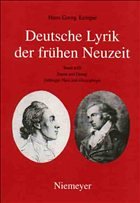The verse of the young Goethe has generally been taken as paradigmatic for the poetry of the Sturm und Drang period. This has led to almost total neglect of the remarkable poetry by Lavater and Herder, Lenz and Stolberg, Karschin and Voss, Schubart's religious verse, and the poetical works of the young Schiller. The present volumes cast a new light on these poets by aligning and confronting them with the theoreticians of the Sturm und Drang, the poets of the Göttinger Hain, and Bürger and Claudius. In so doing it can fairly lay claim to be the first genuinely comprehensive historical review of the poetry of this avant-garde movement in terms of the common problems posed by the period in which it was penned.
Bis heute gelten vor allem die Gedichte des jungen Goethe als paradigmatisch für die Lyrik des Sturm und Drang. Weitgehend vergessen wurden darüber die beachtliche Poesie von Lavater und Herder, Lenz und Stolberg, der Karschin und Voß, die geistlichen Dichtungen Schubarts und die Jugendlyrik Schillers. Die vorliegenden Bände bringen diese Dichter zusammen mit den Theoretikern des Sturm und Drang, den Dichtern des Göttinger Hain sowie mit Bürger und Claudius neu in den Blick und bieten so erstmals eine umfassende Zusammenschau der Lyrik dieser Avantgardebewegung aus problemgeschichtlicher Sicht.
Band 6/II zeigt, wie Hamann, Lavater, Herder und Goethe aus christlichen, mythologischen und hermetischen Traditionen sowie der alten Volkspoesie zusammen mit dem Entwurf einer ganzheitlichen Anthropologie eine neue Autor- und Ausdrucksästhetik entwickeln. In ihrem religiös fundierten Genie-Verständnis erfüllt sich das Autonomiestreben der Aufklärung und erfährt das moderne Individuum - besonders in Goethes Mythopoesie - seine Sakralisierung.
Band 6/III vereinigt von Lenz bis Schiller die Grenzgänger des Geniekults. Zumeist geistlich sozialisiert, orientieren sie sich eher an Klopstock, dem Genie der Empfindsamkeit, aber auch an der Hermetik, und finden von da aus unabhängig von Goethe auch zur Erlebnislyrik, ferner zur balladesken oder idyllischen Erneuerung der Volkspoesie oder wie Schiller zu der für die Moderne ebenfalls bedeutsamen Gedankenlyrik.
Bis heute gelten vor allem die Gedichte des jungen Goethe als paradigmatisch für die Lyrik des Sturm und Drang. Weitgehend vergessen wurden darüber die beachtliche Poesie von Lavater und Herder, Lenz und Stolberg, der Karschin und Voß, die geistlichen Dichtungen Schubarts und die Jugendlyrik Schillers. Die vorliegenden Bände bringen diese Dichter zusammen mit den Theoretikern des Sturm und Drang, den Dichtern des Göttinger Hain sowie mit Bürger und Claudius neu in den Blick und bieten so erstmals eine umfassende Zusammenschau der Lyrik dieser Avantgardebewegung aus problemgeschichtlicher Sicht.
Band 6/II zeigt, wie Hamann, Lavater, Herder und Goethe aus christlichen, mythologischen und hermetischen Traditionen sowie der alten Volkspoesie zusammen mit dem Entwurf einer ganzheitlichen Anthropologie eine neue Autor- und Ausdrucksästhetik entwickeln. In ihrem religiös fundierten Genie-Verständnis erfüllt sich das Autonomiestreben der Aufklärung und erfährt das moderne Individuum - besonders in Goethes Mythopoesie - seine Sakralisierung.
Band 6/III vereinigt von Lenz bis Schiller die Grenzgänger des Geniekults. Zumeist geistlich sozialisiert, orientieren sie sich eher an Klopstock, dem Genie der Empfindsamkeit, aber auch an der Hermetik, und finden von da aus unabhängig von Goethe auch zur Erlebnislyrik, ferner zur balladesken oder idyllischen Erneuerung der Volkspoesie oder wie Schiller zu der für die Moderne ebenfalls bedeutsamen Gedankenlyrik.

